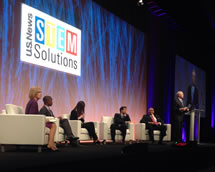University of Maryland Baltimore-County president, students discuss STEM at U.S. News conference
 Washington, DC — When journalist Judy Woodruff was in college, she wanted to be a mathematician, but a professor discouraged her from pursuing math as a career.
Washington, DC — When journalist Judy Woodruff was in college, she wanted to be a mathematician, but a professor discouraged her from pursuing math as a career.
“He thought women had no place in advanced mathematics,” Woodruff recalled during the opening keynote of U.S. News and World Report‘s STEM SOLUTIONS conference Wednesday.
She instead studied political science, a move that worked in her favor, leading her to one day co-anchor PBS Newshour. But the sting of his dismissal remains, and she wonders how many other young women have been told the same thing.
Woodruff brought up the recollection while moderating a discussion between Freeman Hrabowski, the president of University of Maryland-Baltimore County, and three STEM students.
STEM (which stands for science, technology, engineering, and math) fields are notorious for their lack of female and minority practitioners, and Hrabowski is renowned for his work in addressing the issue. The students chosen to join him and Woodruff on stage represented UMBC’s work in encouraging under-represented students to pursue STEM majors.
Dalton Hughes is studying chemical engineering, Mitchel Zavala is studying mechanical engineering, and Lauren Mazzoli is studying computer science and mathematics.
Mazzoli said she was not met with the kind of resistance Woodruff experienced, and instead found an encouraging faculty. Most encouraging, however, she said, has been seeing and interacting with female faculty.
“It’s about the community,” Mazzoli said when asked why she has stuck with STEM when many other students change majors.
(Next page: Why community is key)
Zavala said students often have their doubts when thinking about their place in the discipline. Seeing people like them in the field provides inspiration, and constant motivation from professors is crucial.
“They start thinking ‘am I really smart enough?'” Zavala said. “‘Am I really going to do something incredible?'”
By building a close-knit and encouraging STEM community on campus, students can easily see that they can do something incredible, Hughes said. They’re able to see their peers get good jobs, showing them that there is a way.
Hrabowski also hammered home the importance of community, as well as connecting to the larger professional world of STEM off campus.
“It’s amazing what building a community and having them excited about solving real problems can do,” he said. “Helps them realize that what they are doing makes a difference. It becomes a possibility, then a reality.”
Hrabowski said it’s important to extend that sense of community across disciplines, too. UMBC tries to inject technology into its humanities education, and to inject humanities into its STEM education, he said.
“We don’t just want techy techies,” he said.
Hughes went even further, adding that all kinds of communities can help encourage students. It’s something he said he’s grateful to experience every time he returns to his small hometown in Florida.
“People say, ‘hey, you’re that boy who went to college, and who’s going to medical school,'” he said. “And it charges me up.”
- What does higher-ed look like in 2023? - January 5, 2015
- Are ed-tech startups a bubble that’s ready to burst? - January 1, 2015
- Are MOOCs really dead? - August 28, 2014


Comments are closed.